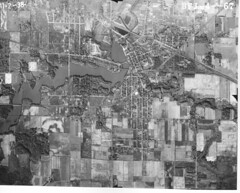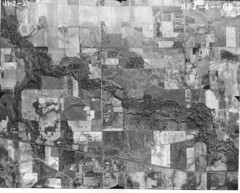A project completed in the autumn of 2011 involving the Sanborn Company, Indiana University, and Historical Information Gatherers, Inc. (funded by a grant from the IndianaView consortium) has made the pre-1924 Sanborn fire insurance maps, now in the public domain, easily available to the public. I have created a page in the Downtown Hobart blog with links to the Hobart maps for 1895, 1902, 1910 and 1922.
I am so busy being grateful to everyone involved in this wonderful project that I can barely take time out to grieve over the fact that there are no Sanborn maps for Ainsworth.
Wednesday, February 29, 2012
Voting, Drinking, Tipping
Or: What the Indiana General Assembly Was Up to in February 1919

(Click on image to enlarge)
From the Hobart News of Feb. 20, 1919.
So, among other things, Indiana women got a very limited right to vote, and an attempt to repeal Indiana's state-wide prohibition was defeated.
The anti-tipping bill is amusing, but the item that follows it is a sobering reminder of the war's cost, even to those who survived it. The "insane" soldiers were likely those with severe post-traumatic stress disorder, and those who had suffered head injuries with brain damage.

(Click on image to enlarge)
From the Hobart News of Feb. 20, 1919.
So, among other things, Indiana women got a very limited right to vote, and an attempt to repeal Indiana's state-wide prohibition was defeated.
The anti-tipping bill is amusing, but the item that follows it is a sobering reminder of the war's cost, even to those who survived it. The "insane" soldiers were likely those with severe post-traumatic stress disorder, and those who had suffered head injuries with brain damage.
Tuesday, February 28, 2012
Scenery (Random Old Photos)
More recent purchases: two not-particularly-illuminating, scenic-beauty-type postcards photographed by August Haase. Both postmarked 1908.

(Click on images to enlarge)
(Verso here.)
That looks like the "dam of bricks" we saw a couple of posts ago. Mr. Haase has just turned his camera a bit further north/northwest. If you look carefully behind the trees, I think you can see a few brickyard stacks.

(Verso here.)
Beyond the stretch of water in the foreground is what looks like the dam, so I suppose if the camera turned left we'd see the old mill. Maybe.
Judging by those trees, I'd say the Deep River was flooding when this picture was taken.

(Click on images to enlarge)
(Verso here.)
That looks like the "dam of bricks" we saw a couple of posts ago. Mr. Haase has just turned his camera a bit further north/northwest. If you look carefully behind the trees, I think you can see a few brickyard stacks.

(Verso here.)
Beyond the stretch of water in the foreground is what looks like the dam, so I suppose if the camera turned left we'd see the old mill. Maybe.
Judging by those trees, I'd say the Deep River was flooding when this picture was taken.
Monday, February 27, 2012
A Mild but Sickly Winter
The winter of the new year was proving milder than usual. With an average temperature of 40 degrees, January 1919 was the warmest on record at Purdue University's meteorological station — a great contrast to the previous January, with its blizzard and its 12 days of below-zero temperatures.
In mid-February, Indiana's fuel administrator sent word to all local fuel administrators (including William Killigrew in Hobart) that their positions were being terminated at the end of the month. They were directed to wrap up the affairs of their offices and make a final report by Washington. The Gazette commented, "This means that after the end of this month all dealers in fuel will be permitted to conduct their business as they please. You may look for cheaper coal."
As the fuel administrators closed down their offices, the mild weather continued.
Unfortunately, so did the Spanish influenza. It defied common wisdom. Back in December, the Gazette's editor had seen some local children, hatless and wearing thin coats, out playing in chilly weather, and chided his readers with an article titled, "No Wonder the 'Flu' Spreads"; but early February found him suggesting that a week of unseasonably warm weather might be responsible for a recent increase in flu cases.
Southeast of Hobart, flu invaded the family of Edward and Louise Schavey — their two little daughters fell ill, and so did the 30-year-old Ed. The girls recovered, but Ed, after some ten days of illness, died on February 13.
February's last Gazette reported that Charles Nitchman had been down for a week with influenza, and Professor Albert Wolkenhauer, the "German teacher," was finally able to leave his house after three weeks' illness and convalescence. On February 25, Mr. and Mrs. John Gray of Hobart lost their eldest son to pneumonia following influenza; the 29-year-old Jesse Gray, who had been farming in Winfield Township, left a widow and a three-year-old child, both sick with flu.
The March 7 Gazette noted that three-year-old Harriet Livingston had "been ill for over a week with peculiar symptoms, bordering on 'sleeping sickness', which is said to be prevalent in some cities following influenza," but she seemed to be improving. (The "sleeping sickness" referred to was encephalitis lethargica, and we still do not know whether it was caused by, or only happened to coincide with, the Spanish influenza.)
Sources:
♦ "Deaths for the Week." Hobart Gazette 21 Feb. 1919.
♦ "'Flu' Increases Death Rate 100 Per Cent in Indiana for Year 1918." Hobart News 6 Mar. 1919.
♦ "Fuel Administrators to Quit." Hobart Gazette 14 Feb. 1919.
♦ "Funeral of Ed Schavey Held Sunday." Hobart News 20 Feb. 1919.
♦ "January Mildest in History of Purdue Weather Bureau." Hobart News 6 Feb. 1919.
♦ "Local Drifts." Hobart Gazette 7 Feb. 1919; 14 Feb. 1919; 28 Feb. 1919; 7 Mar. 1919.
♦ "Mildest Winter in Thirty-nine Years, Says Forecaster." Hobart News 6 Mar. 1919.
♦ "No Wonder the 'Flu' Spreads." Hobart Gazette 6 Dec. 1918.
In mid-February, Indiana's fuel administrator sent word to all local fuel administrators (including William Killigrew in Hobart) that their positions were being terminated at the end of the month. They were directed to wrap up the affairs of their offices and make a final report by Washington. The Gazette commented, "This means that after the end of this month all dealers in fuel will be permitted to conduct their business as they please. You may look for cheaper coal."
As the fuel administrators closed down their offices, the mild weather continued.
Unfortunately, so did the Spanish influenza. It defied common wisdom. Back in December, the Gazette's editor had seen some local children, hatless and wearing thin coats, out playing in chilly weather, and chided his readers with an article titled, "No Wonder the 'Flu' Spreads"; but early February found him suggesting that a week of unseasonably warm weather might be responsible for a recent increase in flu cases.
Southeast of Hobart, flu invaded the family of Edward and Louise Schavey — their two little daughters fell ill, and so did the 30-year-old Ed. The girls recovered, but Ed, after some ten days of illness, died on February 13.
February's last Gazette reported that Charles Nitchman had been down for a week with influenza, and Professor Albert Wolkenhauer, the "German teacher," was finally able to leave his house after three weeks' illness and convalescence. On February 25, Mr. and Mrs. John Gray of Hobart lost their eldest son to pneumonia following influenza; the 29-year-old Jesse Gray, who had been farming in Winfield Township, left a widow and a three-year-old child, both sick with flu.
The March 7 Gazette noted that three-year-old Harriet Livingston had "been ill for over a week with peculiar symptoms, bordering on 'sleeping sickness', which is said to be prevalent in some cities following influenza," but she seemed to be improving. (The "sleeping sickness" referred to was encephalitis lethargica, and we still do not know whether it was caused by, or only happened to coincide with, the Spanish influenza.)
Sources:
♦ "Deaths for the Week." Hobart Gazette 21 Feb. 1919.
♦ "'Flu' Increases Death Rate 100 Per Cent in Indiana for Year 1918." Hobart News 6 Mar. 1919.
♦ "Fuel Administrators to Quit." Hobart Gazette 14 Feb. 1919.
♦ "Funeral of Ed Schavey Held Sunday." Hobart News 20 Feb. 1919.
♦ "January Mildest in History of Purdue Weather Bureau." Hobart News 6 Feb. 1919.
♦ "Local Drifts." Hobart Gazette 7 Feb. 1919; 14 Feb. 1919; 28 Feb. 1919; 7 Mar. 1919.
♦ "Mildest Winter in Thirty-nine Years, Says Forecaster." Hobart News 6 Mar. 1919.
♦ "No Wonder the 'Flu' Spreads." Hobart Gazette 6 Dec. 1918.
Labels:
disease - Spanish influenza,
Gray,
Killigrew,
Livingston,
Nitchman,
Schavey,
Wolkenhauer
Sunday, February 26, 2012
A Dam of Bricks (Random Old Photo)
I've had this postcard for a while but somehow it seems I never got around to it before. It is postmarked 1908 and shows the dam by the old mill.
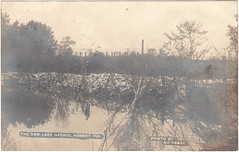
(Click on images to enlarge)
The most interesting thing about it is that the part of the dam where that guy is standing is covered in scrap bricks, no doubt from the brickyards, whose stacks you can see in the background.
Here's the other side of the postcard.
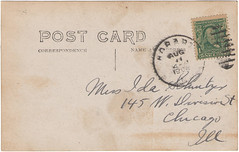

(Click on images to enlarge)
The most interesting thing about it is that the part of the dam where that guy is standing is covered in scrap bricks, no doubt from the brickyards, whose stacks you can see in the background.
Here's the other side of the postcard.

Saturday, February 25, 2012
A Mustache and a Circus; Also, Bums
Just catching up with a couple of old friends …
Recent price increases had led to a boom in one aspect of Charles' business: oiling and repairing harnesses. Within a the last few years, according to the Hobart News, the cost of new harnesses had just about doubled, going from $45 or $50 to $80 or $100. Charles was now so busy during the winter months keeping farmers' old harnesses in working condition that he had hired an assistant.
In February we get news of our friend with the circus.
As he waited for the circus-advertising season to begin, Ellsworth occupied himself with lettering windows and signs for businesses around town.
♦ ♦ ♦
Meanwhile, the Hobart area was beginning to notice effects of the post-World War I recession, but laid-off workers were getting little sympathy from the News:
Sources:
♦ "Local and Personal." Hobart News 30 Jan. 1919; 13 Feb. 1919; 27 Mar. 1919.
♦ "Oiling and Repairing Harness Has Now Become a Regular Occupation." Hobart News 27 Feb. 1919.
Chas. Borger made his appearance last week minus his mustache, which he had worn for about thirty-five years. This was surely a case of parting with an old friend. Those who have noticed the change have remarked that it has caused him to look ten years younger.This comment from the News in January 1919 suggests that Charles Borger had already lost his beard. Alas, we have no photos of him clean-shaven. We do know he eventually let the mustache grow back.
Recent price increases had led to a boom in one aspect of Charles' business: oiling and repairing harnesses. Within a the last few years, according to the Hobart News, the cost of new harnesses had just about doubled, going from $45 or $50 to $80 or $100. Charles was now so busy during the winter months keeping farmers' old harnesses in working condition that he had hired an assistant.
In February we get news of our friend with the circus.
Ellsworth Humes, who for the past few seasons has traveled with the advertising cars of the Hagenbeck-Wallace shows, has been offered a similar position with the Sells-Floto circus for the coming season.No mention here of his having worked for Thurston the magician.
As he waited for the circus-advertising season to begin, Ellsworth occupied himself with lettering windows and signs for businesses around town.
Meanwhile, the Hobart area was beginning to notice effects of the post-World War I recession, but laid-off workers were getting little sympathy from the News:
Since the slackening up of the industries, letting out large numbers of men, tramps and bums are beginning to make their appearance. All we have to say is, the ordinarily healthy individual out of work and no money is entitled to very little consideration. For two years everyone who wanted work in this locality, or almost any other for that matter, could have all the work he wanted at high wages, and if he did not save a small portion of it he should go to South America and live under the cocoanut tree.
Sources:
♦ "Local and Personal." Hobart News 30 Jan. 1919; 13 Feb. 1919; 27 Mar. 1919.
♦ "Oiling and Repairing Harness Has Now Become a Regular Occupation." Hobart News 27 Feb. 1919.
Friday, February 24, 2012
What's the Point? (Random Old Photo)

(Click on images to enlarge)
Another recent purchase. I do not know where "The Point" is, or was. My best guess is that the Point is the current location of Fred Rose Park. It's difficult to tell, with no structures in the background to orient oneself, but then the mere absence of structures tells you something, I suppose.
The sender was Louise Foreman, the recipients Mr. and Mrs. C.H. Harms. The 1910 Census shows a 13-year-old Louise Foreman living on her parents' farm in Porter County; that may be our girl. I believe her father, Henry Foreman, married Minnie Harms in 1896. The closest thing I can find to "Mr. and Mrs. C.H. Harms" in Logansport in 1910 is Charles W. and Cora Harms, a married couple in their 40s. I have not been able to connect any of these people with the Ainsworth Foremans or Harmses.
Here is Louise's message.

[3/7/2014 update] Tim writes in:
Louise is my great-grandmother. She married Lloyd Van De Water. I think he lived in Gary at the time, but his family was from rural areas, I believe.And I may be mistaken about Louise's mother's maiden name being Harms.
I know Louise as Grandma Happner. She had re-married Charles Happner after Lloyd died. She was the sweetest grandmother who made us "goodie bags" full of toys and treats. She also had a daschund named Tippy.
She died in the suburbs of Detroit.
Louise's first marriage, to "F. Vandewater" or "Water Floyd Van de" as it shows up in the Indiana Marriage Collection, took place in Lake County on January 8, 1916. The young couple lived in East Gary (1920 Census) before moving to Detroit (1930 Census). Beyond that I shall not trace them. Louise had nothing to do with Ainsworth, but she did have a dachshund named Tippy.
Thursday, February 23, 2012
A Flu Victim's Estate
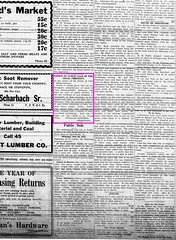
This notice appeared in the Hobart News of February 13, 1919.
Thus were scattered the worldly goods of Ulric Blickensderfer, "an old soldier and a highly respected citizen," and a casualty of the Spanish influenza.
The Blickensderfers' children are a mystery. Neither Ulric's obituary, nor his wife's in 1911, mentioned any children, although both mentioned other surviving relatives. And yet the News, in connection with the disposal of the estate, said offhandedly: "Mr. and Mrs. Blickensderfer are both dead and the sons, who are well-to-do reside in the city" — the only reference I've seen to any children of theirs. I have not been able to find the family in any census.
As for William Raschka, I know of no family connection to the Blickensderfers.
He did, however, have a family connection to the purchasers of Ulric's house in Ainsworth. His niece, Myrtle (née Nelson), and her husband, Ernest Sitzenstock, Jr., bought the six-room frame house and the acre of ground it sat on for $900. I do not know exactly where the house was, or whether it's still standing.
Sources:
♦ "Local and Personal." Hobart News 13 Feb. 1919.
♦ "Mrs. Blickensderfer Dead." Hobart News 16 Nov. 1911.
♦ "Notice of Public Sale of Personal Property." Hobart Gazette 14 Feb. 1919.
♦ "Notice of Public Sale of Personal Property." Hobart News 13 Feb. 1919.
♦ Untitled obituary. Hobart Gazette 11 Oct. 1918.
Wednesday, February 22, 2012
Main Street circa 1908 (Random Old Photo)
I have a little backlog of recent purchases to show off. Here is one of them, showing Main Street in Hobart, looking north from Fourth Street, circa 1908.
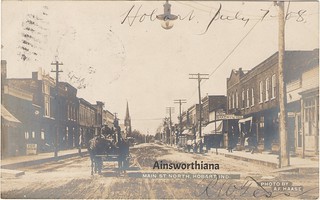
(Click on images to enlarge)
I believe the sender was Reinhold W. Tess, the recipient his mother, Annie (Mrs. John) Tess. The 1900 Census and the 1910 Census show them on Seminary Avenue in Chicago. Reinhold was about 21 when he sent this postcard. What he was doing in Hobart, I have no idea. In 1910 he described himself as a bond salesman.


(Click on images to enlarge)
I believe the sender was Reinhold W. Tess, the recipient his mother, Annie (Mrs. John) Tess. The 1900 Census and the 1910 Census show them on Seminary Avenue in Chicago. Reinhold was about 21 when he sent this postcard. What he was doing in Hobart, I have no idea. In 1910 he described himself as a bond salesman.

Tuesday, February 21, 2012
What Alex Boyd Was Selling
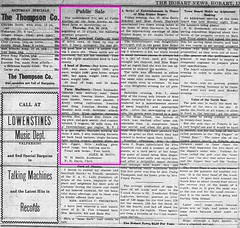
(Click on image to enlarge)
In February 1919, Alex Boyd was going to sell a lot of things on the Boyd farm. Did he intend to quit farming? — I have no idea.
Even more interesting was what he was going to sell off the Boyd farm:

(Click on image to enlarge)
At the end of the month, Trustee Boyd set March 22 as the date when he would take bids for the construction and furnishing of the new school.
Apparently we have here the inception of the brick school building still standing on State Road 51. I did not expect it to be built quite so early — but perhaps these plans will be delayed.
Sources:
♦ "Local Drifts." Hobart Gazette 28 Feb. 1919.
♦ "New Schoolhouse for Ainsworth." Hobart Gazette 7 Feb. 1919.
♦ "Public Sale." Hobart Gazette 7 Feb. 1919.
♦ "Public Sale." Hobart News 6 Feb. 1919.
Monday, February 20, 2012
Harry Carlson (Random Old Photos)
It's hard to keep track of all my material. Long after I got through speculating on whether an unidentified photo might be Harry Carlson, I noticed that months ago I scanned a couple of identified photos of Harry onto one of my flash drives.
So here they are, for comparison.
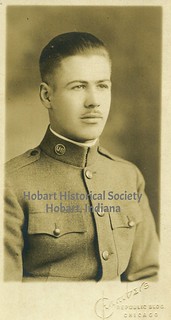
(Click on images to enlarge)
Images courtesy of the Hobart Historical Society.
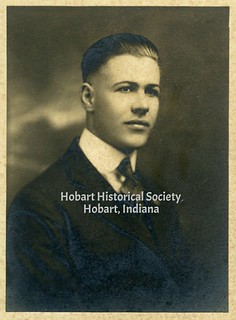
Very strong resemblance to that earlier, unidentified photo, but on the other hand I don't know what his brother Paul looked like as an adult.
So here they are, for comparison.

(Click on images to enlarge)
Images courtesy of the Hobart Historical Society.

Very strong resemblance to that earlier, unidentified photo, but on the other hand I don't know what his brother Paul looked like as an adult.
Sunday, February 19, 2012
Severance News, Bad and Good
The "Local Drifts" in the Hobart Gazette of February 7, 1919 carried items about both Alberta Severance and her soldier husband, George Jr.
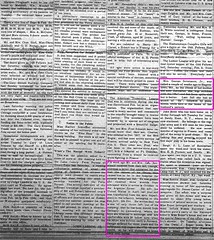
(Click on image to enlarge)

(Click on image to enlarge)
Labels:
disease - Spanish influenza,
Severance,
World War I
Saturday, February 18, 2012
1939 Aerial Photos of Hobart: South of Hobart
Friday, February 17, 2012
"Practically All His Life"
Late in January 1919, Charles Maybaum, Jr. left his Ross Township home to move in with Arthur and Olive Weiler in Porter County. The Gazette noted that he had "spent practically all his life on the farm south of Ainsworth." Omitted from "practically all his life" were the first five years of it, spent in Germany where he was born, and the journey of over 4,000 miles that brought him to Ainsworth. Aside from that, then, let us say that he was an unadventurous homebody, at the age of 52 still a bachelor living in the old family home with his widowed mother, Caroline.
A week later comes news that gives us an idea of the reason for the move: the 76-year-old Caroline was sick, and had been for several weeks. She was under the care of her daughter, Hattie Sizelove. Hattie may have come to Caroline's house, or brought Caroline to her own; either way, apparently the old Maybaum household was disrupted enough to make Charles leave the home where he had spent practically all his life.
Sources: "Local Drifts." Hobart Gazette 31 Jan. 1919; 7 Jan. 1919.
A week later comes news that gives us an idea of the reason for the move: the 76-year-old Caroline was sick, and had been for several weeks. She was under the care of her daughter, Hattie Sizelove. Hattie may have come to Caroline's house, or brought Caroline to her own; either way, apparently the old Maybaum household was disrupted enough to make Charles leave the home where he had spent practically all his life.
Sources: "Local Drifts." Hobart Gazette 31 Jan. 1919; 7 Jan. 1919.
Thursday, February 16, 2012
1939 Aerial Photos of Hobart: Southwest of Hobart
The next three photos move north from the one we've just seen to show us the farmland and woods southwest and west of Hobart. These photos overlap each other somewhat.
In this first one, the Grand Trunk Railroad runs diagonally across the lower third of the photo, while at the top you can see the Deep River beginning to widen into Lake George.
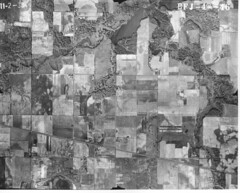
(Click on images to enlarge)
The next two just continue moving north.
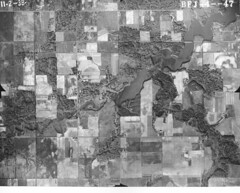
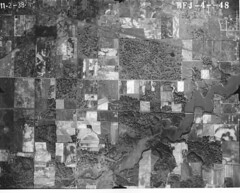
Here's that last one again with some of the features labeled.
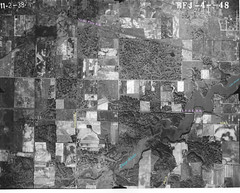
In this first one, the Grand Trunk Railroad runs diagonally across the lower third of the photo, while at the top you can see the Deep River beginning to widen into Lake George.

(Click on images to enlarge)
The next two just continue moving north.


Here's that last one again with some of the features labeled.

Wednesday, February 15, 2012
Fred Thompson
Exactly two years after the death of his father, Alexander, Fred Thompson followed him out of this world.
Fred had grown up on the Thompson farm south of Ainsworth, brought there so young that he probably had little memory of his first home in Illinois. But as a young man he left the farm and never looked back. It was in 1886, when he was just 23 years of age, that he moved to Hobart and married the 19-year-old Estella White.
I do not have many details about Fred's life in Hobart. Stella died in 1905; three years later Fred married Amelia Triebess. For the most part, he earned his living working for other people, but twice he went into business for himself: once operating a livery service, and once, in partnership with his father, starting a grocery store that they sold in 1913 to Sauter and Mackeldey. (On that occasion, Fred said he intended to take his first vacation in 18 years.)
In 1917 he successfully ran for election as a town trustee. The Gazette later remarked that he "took a decided interest in the welfare of the town and was a faithful attendant at all Board meetings." He also sat on the board of directors of the First State Bank. I don't know what his day job had been since the sale of the grocery, but in 1918 he hired on at Paul Newman's hardware store.
Like many others in Hobart, Fred came down with Spanish influenza that autumn, but after a couple of weeks off, he returned to his job, apparently in good health again. So it came as a shock when, on the afternoon of January 20, 1919, he collapsed, unconscious, in the hardware store.
He was carried home and put to bed. Though he continued unconscious, in the first few days of his illness his doctor and family were hopeful that he would recover, as he had from a previous mild stroke some 14 years earlier. But as the days went by and Fred remained in a coma, unable to take nourishment, hope faded. After ten days, he quietly passed away, never having regained consciousness. He was just 55 years of age.
Surviving him were Amelia (neither marriage had produced any children) and a brother, William, who lived in Crown Point. His younger brother, Hugh, had preceded him in death.
The News eulogized him as "a straightforward, conscientious citizen who was an American through and through,* who believed in equal rights to all and special privileges to none. He had the respect of all who knew him."
Fred was laid to rest in Hobart Cemetery, beside his first wife.
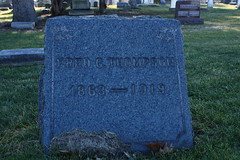
(Click on images to enlarge)
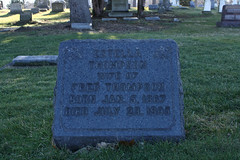
_____________________________
*I suppose it's indicative of the spirit of the times that hyper-patriotism would seep even into an obituary.
Sources:
♦ 1880 Census.
♦ "Fred Thompson Suffers a Stroke of Paralysis, Monday." Hobart News 23 Jan. 1919.
♦ "Frederick G. Thompson." Hobart Gazette 7 Feb. 1919.
♦ "Funeral of Trustee Frederick Thompson Held Last Sunday." Hobart News 6 Feb. 1919.
♦ Indiana Marriage Collection.
♦ "Local and Personal." Hobart News 30 Jan. 1919.
♦ "Local Drifts." Hobart Gazette 31 Jan. 1919.
Fred had grown up on the Thompson farm south of Ainsworth, brought there so young that he probably had little memory of his first home in Illinois. But as a young man he left the farm and never looked back. It was in 1886, when he was just 23 years of age, that he moved to Hobart and married the 19-year-old Estella White.
I do not have many details about Fred's life in Hobart. Stella died in 1905; three years later Fred married Amelia Triebess. For the most part, he earned his living working for other people, but twice he went into business for himself: once operating a livery service, and once, in partnership with his father, starting a grocery store that they sold in 1913 to Sauter and Mackeldey. (On that occasion, Fred said he intended to take his first vacation in 18 years.)
In 1917 he successfully ran for election as a town trustee. The Gazette later remarked that he "took a decided interest in the welfare of the town and was a faithful attendant at all Board meetings." He also sat on the board of directors of the First State Bank. I don't know what his day job had been since the sale of the grocery, but in 1918 he hired on at Paul Newman's hardware store.
Like many others in Hobart, Fred came down with Spanish influenza that autumn, but after a couple of weeks off, he returned to his job, apparently in good health again. So it came as a shock when, on the afternoon of January 20, 1919, he collapsed, unconscious, in the hardware store.
He was carried home and put to bed. Though he continued unconscious, in the first few days of his illness his doctor and family were hopeful that he would recover, as he had from a previous mild stroke some 14 years earlier. But as the days went by and Fred remained in a coma, unable to take nourishment, hope faded. After ten days, he quietly passed away, never having regained consciousness. He was just 55 years of age.
Surviving him were Amelia (neither marriage had produced any children) and a brother, William, who lived in Crown Point. His younger brother, Hugh, had preceded him in death.
The News eulogized him as "a straightforward, conscientious citizen who was an American through and through,* who believed in equal rights to all and special privileges to none. He had the respect of all who knew him."
Fred was laid to rest in Hobart Cemetery, beside his first wife.

(Click on images to enlarge)

_____________________________
*I suppose it's indicative of the spirit of the times that hyper-patriotism would seep even into an obituary.
Sources:
♦ 1880 Census.
♦ "Fred Thompson Suffers a Stroke of Paralysis, Monday." Hobart News 23 Jan. 1919.
♦ "Frederick G. Thompson." Hobart Gazette 7 Feb. 1919.
♦ "Funeral of Trustee Frederick Thompson Held Last Sunday." Hobart News 6 Feb. 1919.
♦ Indiana Marriage Collection.
♦ "Local and Personal." Hobart News 30 Jan. 1919.
♦ "Local Drifts." Hobart Gazette 31 Jan. 1919.
Tuesday, February 14, 2012
1939 Aerial Photos of Hobart: West of Ainsworth
OK, finally getting back to these few aerial photos of Hobart in 1939, only one of which I already posted.
Here we have the area west of Ainsworth, surrounding the old Lincoln Highway. The far left of this photo shows the area where I-65 now runs north-south. The new Route 30 runs east-west across the bottom of the photo. Other than that, mostly just farmland.
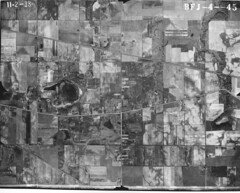
(Click on images to enlarge)
Here it is again with some of the features labeled.
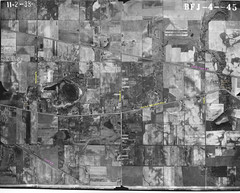
Here we have the area west of Ainsworth, surrounding the old Lincoln Highway. The far left of this photo shows the area where I-65 now runs north-south. The new Route 30 runs east-west across the bottom of the photo. Other than that, mostly just farmland.

(Click on images to enlarge)
Here it is again with some of the features labeled.

Monday, February 13, 2012
The End of Company K
The bad news came to Captain Charles Reeve late in January 1919: Co. K was doomed. The adjutant general of Indiana had ordered more than a dozen state militia companies mustered out of service, and Hobart's was one of them. (Valparaiso's was another.)
Co. K had over a hundred men in its ranks, with uniforms and rifles; several hundred dollars in its treasury; a silk flag, and a great deal of pride.
Captain Reeve set about preparing for the end, whenever it might officially come. He had to prepare discharge papers for all his men, compile muster rolls, and collect, list and pack up any company property that had to be returned to the state, such as uniforms. Early in February he notified the Indiana attorney general that by the 11th his work would be done and his company ready to be mustered out at the state's pleasure.
A week or so later, Captain Reeve heard back from the state. February 27 was set as the day.
But the captain's preparations were not quite complete. A young Michigan City man named Pedroski (first name not given) had at one point joined Company K and received a uniform; he still had that uniform and failed, or outright refused, to return it. After tracking Pvt. Pedroski down in South Bend, Captain Reeve sent Sgt. Kenneth Humes and Pvt. Milton Ballantyne after him. They returned the evening of Sunday, February 16, with their prisoner, and put him in the Hobart jail. On Tuesday night, facing a court martial, Pvt. Pedroski told a "hard luck tale," presumably to the effect that he was hanging onto his uniform because he had no other clothes to wear and no money to buy them. The court's response was to give him a suit of civilian clothes, make him promise to pay back $20 in costs, and — once he had changed his uniform for the civvies — let him go.
(Incidentally, beside this story in the News ran a short article reporting that the subject of the previous summer's manhunt had been caught, and tried and convicted of the assault on Mrs. Davenport: one John Sims of Gary, a former serviceman who appeared in court in uniform. The article did not say how he had been found.)
February 27 arrived at last, and brought with it Colonel Charles A. Garrard of the Indiana militia. That evening he completed the mustering-out of all of Co. K's members, excepting the captain and two lieutenants. Some $700 in the company's treasury was distributed among its members in proportion to their attendance at drills. The silk flag was given into the custody of the members who were Odd Fellows; they intended to display it, and a membership roster, in a glass case at the Hobart public library.
Afterwards, the former militiamen and their families held a dance in celebration of the adventure and companionship of Co. K, and the little company marched into history.
♦ ♦ ♦
The following Co. K membership list comes from a list on display at the Hobart Historical Society. It may be the membership roster mentioned above, but I don't know for certain. I promise it's the last Co. K membership list I'm going to post!
Militia Roster 1917-1919
Sources:
♦ "Co. K Militia Boy Given Summary Courtmartial." Hobart News 20 Feb. 1919.
♦ "Co. K Mustered Out." Hobart Gazette 28 Feb. 1919.
♦ "Co. K Ready to Be Mustered Out." Hobart Gazette 7 Feb. 1919.
♦ "Hobart Militia Co. One of Fourteen to Be Mustered Out." Hobart News 30 Jan. 1919.
♦ "Hobart Militia Co. to Disband." Hobart Gazette 31 Jan. 1919.
♦ "The Negro Assaulter of Mrs. Davenport Convicted and Sentenced." Hobart News 20 Feb. 1919.
♦ "Will Muster Out Co. K February 27." Hobart Gazette 14 Feb. 1919.
Co. K had over a hundred men in its ranks, with uniforms and rifles; several hundred dollars in its treasury; a silk flag, and a great deal of pride.
Captain Reeve set about preparing for the end, whenever it might officially come. He had to prepare discharge papers for all his men, compile muster rolls, and collect, list and pack up any company property that had to be returned to the state, such as uniforms. Early in February he notified the Indiana attorney general that by the 11th his work would be done and his company ready to be mustered out at the state's pleasure.
A week or so later, Captain Reeve heard back from the state. February 27 was set as the day.
But the captain's preparations were not quite complete. A young Michigan City man named Pedroski (first name not given) had at one point joined Company K and received a uniform; he still had that uniform and failed, or outright refused, to return it. After tracking Pvt. Pedroski down in South Bend, Captain Reeve sent Sgt. Kenneth Humes and Pvt. Milton Ballantyne after him. They returned the evening of Sunday, February 16, with their prisoner, and put him in the Hobart jail. On Tuesday night, facing a court martial, Pvt. Pedroski told a "hard luck tale," presumably to the effect that he was hanging onto his uniform because he had no other clothes to wear and no money to buy them. The court's response was to give him a suit of civilian clothes, make him promise to pay back $20 in costs, and — once he had changed his uniform for the civvies — let him go.
(Incidentally, beside this story in the News ran a short article reporting that the subject of the previous summer's manhunt had been caught, and tried and convicted of the assault on Mrs. Davenport: one John Sims of Gary, a former serviceman who appeared in court in uniform. The article did not say how he had been found.)
February 27 arrived at last, and brought with it Colonel Charles A. Garrard of the Indiana militia. That evening he completed the mustering-out of all of Co. K's members, excepting the captain and two lieutenants. Some $700 in the company's treasury was distributed among its members in proportion to their attendance at drills. The silk flag was given into the custody of the members who were Odd Fellows; they intended to display it, and a membership roster, in a glass case at the Hobart public library.
Afterwards, the former militiamen and their families held a dance in celebration of the adventure and companionship of Co. K, and the little company marched into history.
The following Co. K membership list comes from a list on display at the Hobart Historical Society. It may be the membership roster mentioned above, but I don't know for certain. I promise it's the last Co. K membership list I'm going to post!
Militia Roster 1917-1919
Sources:
♦ "Co. K Militia Boy Given Summary Courtmartial." Hobart News 20 Feb. 1919.
♦ "Co. K Mustered Out." Hobart Gazette 28 Feb. 1919.
♦ "Co. K Ready to Be Mustered Out." Hobart Gazette 7 Feb. 1919.
♦ "Hobart Militia Co. One of Fourteen to Be Mustered Out." Hobart News 30 Jan. 1919.
♦ "Hobart Militia Co. to Disband." Hobart Gazette 31 Jan. 1919.
♦ "The Negro Assaulter of Mrs. Davenport Convicted and Sentenced." Hobart News 20 Feb. 1919.
♦ "Will Muster Out Co. K February 27." Hobart Gazette 14 Feb. 1919.
Sunday, February 12, 2012
Somehow Involving Cal Shearer (Random Old Photo)
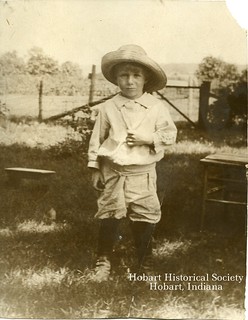
(Click on image to enlarge)
Image courtesy of the Hobart Historical Society.
This developed photo was sitting atop the glass plates in the Mary Kitchen beef hash box.
In the upper left-hand corner of the back, someone has written: "___on Cal Shearer" (if I'm deciphering it right). The blank is where the corner was torn off. So I guess this photo somehow involved Cal Shearer, either the elder or the younger … but exactly how is a mystery.
Saturday, February 11, 2012
We've Got Ourselves a Farm Bureau
(No Thanks to You Slackers)
Chas. Chester left Monday for Indianapolis to take a hand in the framing of laws in which the farmers are interested or not interested. He will probably be there all week.With that "interested or not interested" comment, the Valentine's Day issue of the Gazette took a swipe at the farmers of Hobart Township, who had proven themselves slackers when it came to organizing the new Farm Bureau.
At a meeting in Crown Point on February 1, 1919, several hundred farmers had come together to dissolve the Lake County Farmers' Association and in its place to formally organize the new Lake County Farm Bureau. They elected officers (Alex Boyd of Ross Township being Second Vice President) and directors, and each township reported on its membership figures. The Bureau now boasted a total of some 800 members, but a mere nine of those were in Hobart Township. It was the second-lowest membership in Lake County, beat out only by Calumet Township's six. Other nearby farming areas had done much better; for example, Ross Township had 120 members, West Creek 135, Winfield 65.
The next week's Gazette carried a short article by Hobart Township drive chairman John Larson, Jr., titled, "What's The Matter With Hobart?" — a question he claimed was asked over and over at the organizational meeting, especially since only one of Hobart Township's nine members (presumably John himself) showed up at that meeting. John was given the task of corralling enough of Hobart Township's slackers to elect a township director, hence his Gazette article. He chiding his fellow farmers and urged them to redeem themselves at a meeting in the Hobart library on the evening of February 7.
"A rather small number of farmers" came to that meeting, but they managed to elect themselves a director: William Bach. By the time Charles Chester left for Indianapolis, the Lake County Farm Bureau's total membership had risen to 1,000, Hobart Township's to 15.
I do not know exactly what Charles intended to lobbying for or against. He may have been helping the three Farm Bureau officers who reportedly planned to go to the capitol to "protest against the establishment of a criminal court in Lake county and … against the tuberculosis bill." No, I don't know why the farmers would be against a criminal court, unless it was a matter of higher taxes, nor do I know what the "tuberculosis bill" was — I can only guess that it involved stricter requirements for tuberculin testing of cattle.
Out of Washington, D.C. came some good news for the farmers — the House agricultural committee was making plans to guarantee the price of wheat for 1919 at $2.26.* If the market price fell below that, the consumer would pay the lower price and the federal government would pay the farmer the difference.
Lake County agricultural agent Virgil Place was making himself useful. He offered advice about the planting of spring wheat, and pointed out that Farm Bureau members could get limestone fertilizer at a reduced price. He also began to urge methodical steps toward improving the dairy cattle of Lake County; with their advantageous location — in the heart of good agricultural land, but also near Chicago's large and thirsty population and its transportation facilities — Lake County's dairy farmers need only organize themselves to improve the breeding, testing and management of their cows "to become noted nationally as a county where exceptionally good, pure bred Holstein cattle are produced."
_______________________
*Per bushel, I presume. A newspaper addressing a farming community does not need to specify such things.
Sources:
♦ "Hobart Farmers Elect Directors." Hobart Gazette 14 Feb. 1919.
♦ "Lake County Farm Bureau Organized at Crown Pt. Saturday." Hobart News 6 Feb. 1919.
♦ "Local Drifts." Hobart Gazette 14 Feb. 1919.
♦ "News from the County Agent." Hobart News 20 Feb. 1919; 27 Feb. 1919.
♦ "Spring Wheat." Hobart Gazette 7 Mar. 1919.
♦ "What's The Matter With Hobart?" Hobart Gazette 7 Feb. 1919.
♦ "Wheat Price to Stand — Gov't to Pay Difference." Hobart News 13 Feb. 1919.
Friday, February 10, 2012
Maybe a Carlson (Random Old Photo)

(Click on image to enlarge)
Image courtesy of the Hobart Historical Society.
This little developed portrait was in the cigar box with the small glass-plate negatives. The subject is not identified. Notes on the back read: "2 1/4 W&W Preters[?] 65836."
If you ask me, this young man has some family resemblance to Eric Carlson, but I don't think it's Eric himself — maybe one of his younger brothers, Paul or Harry, a few years after the glass-plate images.
Thursday, February 9, 2012
Ross Township Trustee's Annual Report: 1918

(Click on image to enlarge)
From the Hobart Gazette of January 31, 1919.
If I hadn't heard of any of these people, this would make for very dry reading. (I suppose for some of you, it makes for dry reading anyway.) But I like to hear what old friends have been up to, and to be reminded of the existence of some people who've been quiet lately.
I see our friends Jennie Chester, Elsie Gruel and Pearl Ols are still teaching (as well as Pearl's older sister, Bessie); also Olive Wood.
Gust Lindborg is still repairing school busses. Charles Goldman furnished the schools with two brooms and other unspecified supplies, and the schoolrooms were kept warm with coal and wood from Shearer & Emery, and William Wollenberg.
So many familiar names working on the roads, shoveling snow, driving school busses. Apparently even Charles Chester got involved in "extra buss service," whatever that might be.
Lena Hunter and Owen Nelson, among others, lost chickens to roaming dogs.
There are a few local names that I'm surprised to find absent from the report, such as Gruel (aside from Elsie), Nolte and Waldeck.
Wednesday, February 8, 2012
Fluffy (Unidentified Glass-Plate Image)
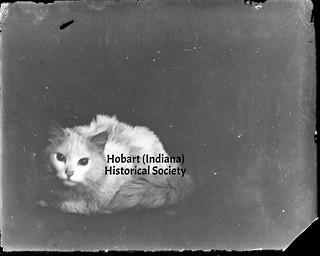
(Click on image to enlarge)
Image courtesy of the Hobart Historical Society.
There is no identification on this one, so I don't know that the cat's name was actually Fluffy. It might have been Mr. Snuggles, or Queen Victoria, or Jack.
And with this, folks, we come to the end of our glass-plate collections. I am very sorry to see the last of them. When I began posting these, I wondered if the thrill of discovery hadn't made me overestimate their merit; now I'm sure that's not the case. They really are a remarkable series of photos for the time, so informal and intimate, and thank goodness some of them are identified.
Now that I've gotten addicted to posting random old photos, I intend to keep doing it. Goodness knows there are plenty more pictures at the museum, some identified, some not.
Tuesday, February 7, 2012
"Oh, You're Not Bootleggers!"
"And You're Not Chicago Bandits!"
On the evening of January 27, 1919, a cozy little auto party drove out of Hobart. Emil Scharbach, his wife, Emma, and his father, William, were accompanied by their friend, Hobart attorney Roscoe Peddicord. They headed west: Emil and Roscoe to attend a meeting and banquet at the Hammond Country Club — just over the Illinois state line — William and Emma to visit the family of Frank Scharbach (another of William's sons), who now lived in Hammond.
When all the banqueting and visiting were done, it was well after 10 p.m., and the Scharbach-Peddicord party headed back toward Hobart, probably along the Ridge road. As they neared the town of Highland, a large, fast car passed them in the darkness. When they came to Highland's main intersection, they found the same large car stopped crossways in the road, blocking their passage, and several men signaling them to stop. Emil, at the wheel, obeyed the signal, although his heart beat fast, for his first thought was that they were being held up by Chicago bandits.
The men approached the car, and fear gave way to surprise and relief as the Hobart party recognized their old friend, Sheriff Lewis Barnes, with several deputies.
Sheriff Barnes was equally surprised: he had thought he was catching bootleggers! On the lookout for a red car from South Bend, supposedly carrying booze in from Illinois, the sheriff had seen this closed car making a suspicious night journey east from the state line — in the darkness he could not recognize the Scharbach car or its occupants — and so he gave chase.
The intended arrest dissolved into a happy reunion. The Hobart party carried no liquor — so the Gazette said; Sheriff Barnes did not insult his old friends by searching their car. After greetings and explanations and laughter, the Hobart party headed for home again, and the sheriff and his men went back to patrolling for the South Bend bootleggers in the red car.
"Sheriff Barnes is to be congratulated for his vigilance," concluded the Gazette. The News added that despite the efforts of law enforcement, "booze is brought into the state in large quantities. South Bend parties, it is said, are large offenders who have been making trips through Lake county."
♦ ♦ ♦
For a few weeks there had been talk around Hobart of a "mysterious woman in black" lurking about the town's side streets, glimpsed by various people at various hours of the night. Similar reports came from other towns, such as Whiting. Children lived in fear that the woman in black would come in the night and get them. No one knew the identity of this person or what business brought her out in the streets, if, indeed, she was not the figment of overactive imaginations, but the News added that the latest theory was "that 'he' or 'she' or 'it' is a walking 'blind pig' dispensing vile booze to the thirsty."
Sources:
♦ 1920 Census.
♦ "Hobart Citizens Held Up at Highland Monday Night." Hobart News 30 Jan. 1919.
♦ Lake County Encyclopedia.
♦ "Sheriff Does Effective Policing." Hobart Gazette 31 Jan. 1919.
♦ "The 'Mysterious Woman in Black' Visits Hobart." Hobart News 6 Feb. 1919.
When all the banqueting and visiting were done, it was well after 10 p.m., and the Scharbach-Peddicord party headed back toward Hobart, probably along the Ridge road. As they neared the town of Highland, a large, fast car passed them in the darkness. When they came to Highland's main intersection, they found the same large car stopped crossways in the road, blocking their passage, and several men signaling them to stop. Emil, at the wheel, obeyed the signal, although his heart beat fast, for his first thought was that they were being held up by Chicago bandits.
The men approached the car, and fear gave way to surprise and relief as the Hobart party recognized their old friend, Sheriff Lewis Barnes, with several deputies.
Sheriff Barnes was equally surprised: he had thought he was catching bootleggers! On the lookout for a red car from South Bend, supposedly carrying booze in from Illinois, the sheriff had seen this closed car making a suspicious night journey east from the state line — in the darkness he could not recognize the Scharbach car or its occupants — and so he gave chase.
The intended arrest dissolved into a happy reunion. The Hobart party carried no liquor — so the Gazette said; Sheriff Barnes did not insult his old friends by searching their car. After greetings and explanations and laughter, the Hobart party headed for home again, and the sheriff and his men went back to patrolling for the South Bend bootleggers in the red car.
"Sheriff Barnes is to be congratulated for his vigilance," concluded the Gazette. The News added that despite the efforts of law enforcement, "booze is brought into the state in large quantities. South Bend parties, it is said, are large offenders who have been making trips through Lake county."
For a few weeks there had been talk around Hobart of a "mysterious woman in black" lurking about the town's side streets, glimpsed by various people at various hours of the night. Similar reports came from other towns, such as Whiting. Children lived in fear that the woman in black would come in the night and get them. No one knew the identity of this person or what business brought her out in the streets, if, indeed, she was not the figment of overactive imaginations, but the News added that the latest theory was "that 'he' or 'she' or 'it' is a walking 'blind pig' dispensing vile booze to the thirsty."
Sources:
♦ 1920 Census.
♦ "Hobart Citizens Held Up at Highland Monday Night." Hobart News 30 Jan. 1919.
♦ Lake County Encyclopedia.
♦ "Sheriff Does Effective Policing." Hobart Gazette 31 Jan. 1919.
♦ "The 'Mysterious Woman in Black' Visits Hobart." Hobart News 6 Feb. 1919.
Labels:
Barnes,
liquor/alcohol - use and/or law,
Peddicord,
Scharbach
Monday, February 6, 2012
Louis Tree (Glass-Plate Image)

(Click on image to enlarge)
Image courtesy of the Hobart Historical Society.
Identified as "Louis Tree/No. 87."
This is probably the son of Sam and Lauretta Tree, born in 1885. The 1900 Census describes him, at the age of 15, as a "day laborer," like his father; ten years later he is a "laborer" doing "odd jobs." I'm not sure I've found him in the 1920 Census, but it does show a 35-year-old Louis Tree in Grand Rapids, Michigan, with a wife, Myrtle, and baby boy, Samuel, which sounds likely.
We've seen that parlor before — the same wallpaper, calendar and curtains; and if you look under that little table in this picture, you can see the cute little doggie statuette.
So — is that Sam Tree with the doggie? And Louis with the trumpet? And maybe Lauretta with the book? And the elderly lady, that's Grandma Tree visiting from Canada.*
No clue who Mr. Badge is in the other two pictures. I don't see any member of the extended Tree family described in any census as doing something that would involve a badge. Maybe we've got some members of the Stephen Tree family in that big group, but this is getting a little too speculative even for me.
__________________________
*Conjecture drawn from the clear blue sky.
Sunday, February 5, 2012
A New Hupmobile, and
Better Roads to Drive It On
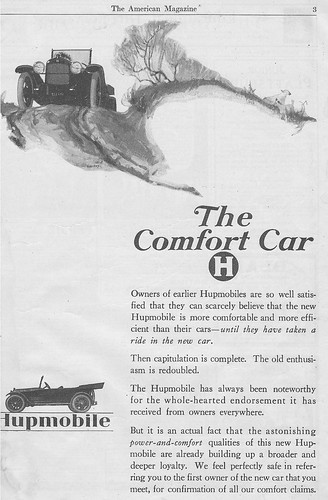
(Click on image to enlarge)
A 1918 Hupmobile advertisement from The American Magazine.
"Dr. Clara Faulkner drives a new Hupmobile, purchased from Roper Bros. agents," quoth the Gazette of January 31, 1919 — probably at the request of the Roper brothers, but it also did no harm to tell Dr. Faulkner's potential patients that she had a powerful new car in which to reach them in a hurry, if need be.
The same issue carried numerous petitions to the Lake County Board of Commissioners, and several of those were for improvements to roads. In Ross Township, William G. Woods et al. requested that a portion of the road to the county seat, now known as Taft Street, be widened and surfaced with "free gravel or macadamized stone." The portion in question ran south from the Lincoln Highway (73rd Avenue) to about 93rd Avenue (if I'm reading it right), and apparently the road north and south of that portion had previously been macadamized.
Here's the petition, for what it's worth. Sorry about the terrible quality, but this is what I have to deal with on microfilm.
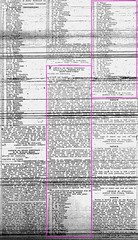
(Click on image to enlarge)
Sources:
♦ "Local Drifts." Hobart Gazette 31 Jan. 1919.
♦ "Notice of Road Petition." Hobart Gazette 31 Jan. 1919.
Saturday, February 4, 2012
Surly Baby's Feeding Time
(Unidentified Glass-Plate Image)

(Click on image to enlarge)
Image courtesy of the Hobart Historical Society.
Surly Baby doesn't even look happy when she's being fed. I think the woman holding the baby in this photo is the one seated at the right in the linked photo, judging by what I can see of her face, and also the sunburst pin, and the topknot in her hair.
I believe that's Tekla Anderson at left.
No identifying notes on the original, however.
Friday, February 3, 2012
Gary, the City of Magic
Just a little article about wide-eyed dreamers coming to "Gary, the city of magic." I don't know exactly what the Home Service office was; I have the impression it was a branch of the Red Cross intended to help returning veterans find jobs.

(Click on image to enlarge)
From the Hobart News of January 30, 1919.
Logansport wasn't exactly a one-horse town at the time, with a population over 21,000 in 1920, but I suppose it was small enough to be dull. I don't know why Mary Stone didn't just go to Chicago. Too large and intimidating, perhaps.
Somehow I missed Gary's magic era — I am not old enough, or didn't get out of the house enough in my youth.

(Click on image to enlarge)
From the Hobart News of January 30, 1919.
Logansport wasn't exactly a one-horse town at the time, with a population over 21,000 in 1920, but I suppose it was small enough to be dull. I don't know why Mary Stone didn't just go to Chicago. Too large and intimidating, perhaps.
Somehow I missed Gary's magic era — I am not old enough, or didn't get out of the house enough in my youth.
Thursday, February 2, 2012
Goosey BFFs (Random Pointless Photo)

(Click on image to enlarge)
When I was photographing the reconstructed levee the other day, I noticed this pair among the usual crowd of waterfowl — a snow goose and a Canada goose, apparently inseparable.
I don't know much about geese, so I don't know how unusual this is, but it's cute, anyway.
Lace and Jewelry (Unidentified Glass-Plate Image)

(Click on image to enlarge)
Image courtesy of the Hobart Historical Society.
Another photo of a photo, with no identifying information. The original was a formal portrait, with the subject decking herself out in an elaborate lace and organdy dress, with a perfectly tied hair bow and an abundance of jewelry. Perhaps the portrait was to commemorate a special occasion, like her high-school graduation.
The sunburst brooch on her collar resembles the one worn by the woman seated at the far right in the surly baby picture, but I can't say I see any resemblance between the two women.
Wednesday, February 1, 2012
Dam Progress Report (Random Pointless Photos)
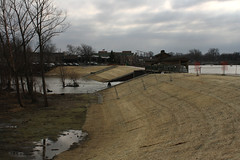
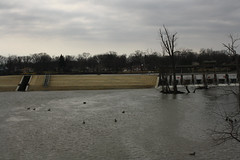
(Click on images to enlarge)
Work on the dam is finished enough that they've taken away all the heavy equipment, but unfinished enough that you still can't walk on the bridge.
The levee certainly looks more substantial now. All that work has had the unfortunate side effect of making the area look barren and desolate, but after a couple of summers I expect it will look more inviting. Only, they had to sacrifice the mulberry tree where my grandniece liked to pick berries, and that is not going to grow back.
Youthful Cantankerousness
I never knew Carl Krausse, but I have heard stories about him. Indeed I have. The stories always involve the years when he managed Stommel's, and include the phrase "quite a character" or "something else." The specifics range from his yelling at people for parking on the public street in front of his store, to his refusing to sell a customer something if he found out the customer looked at it elsewhere first, to his keeping guns hidden under the merchandise displays so he could shoot any would-be robbers.
So I was amused when I came across this letter he wrote to the Gazette's editor from New York, where he was stationed with the army. He was only about 23 years old, but already we get a hint of that legendary cantankerousness.
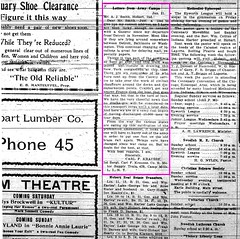
(Click on image to enlarge)
From the Hobart Gazette of January 24, 1919.
So I was amused when I came across this letter he wrote to the Gazette's editor from New York, where he was stationed with the army. He was only about 23 years old, but already we get a hint of that legendary cantankerousness.

(Click on image to enlarge)
From the Hobart Gazette of January 24, 1919.
Subscribe to:
Posts (Atom)

